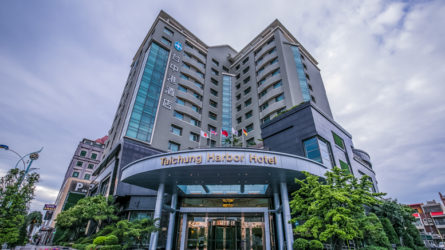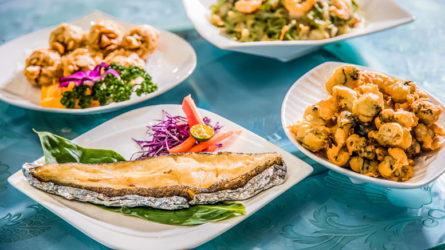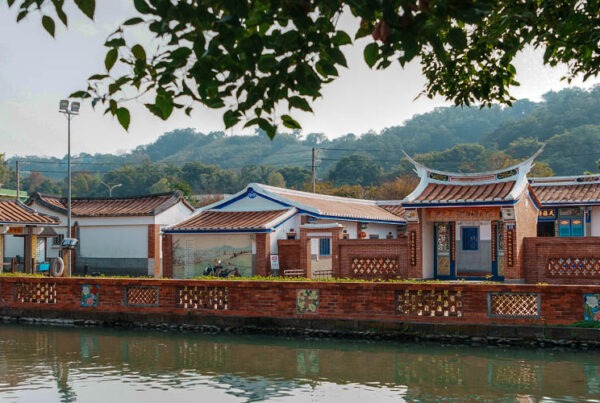
Taking in the Taichung Coast from the Aofeng Hill Viewing Platform
The Taichung Coast area is catching the eye of ever more international travelers. What’s there to see and experience? Fishing harbors and harbor cruises, vast wetlands and scenic plateau-top lookouts, old-time eateries, shops, and neighborhood enclaves, archeological digs and ancestral residences, and dynamic tourist-inviting cultural-creative enterprises serving everyone from youngsters through seniors.
Text: Rick Charette; Photos: Chen Cheng-kuo
Taichung, west-central Taiwan’s hub city, is a dynamic place long known for universities and intellectual ferment as well as for blue-collar industrial dynamism. Its factories and major port played a key role in Taiwan’s famed “economic miracle” of the past century, and they remain the driving force behind central Taiwan’s economic élan, the scholastic institutions playing a key supporting role. Over the past two decades, however, a third actor has entered the play – the city has been reinventing itself as a destination of cultural and recreational enticements, creating an ever-widening array of resident- and tourist-friendly cultural and green-space attractions.The city’s central area is in a basin. In this article we visit its coastal area, on the Taiwan Strait, separated from the core by the low-elevation Dadu Plateau. The north-south National Freeway No. 3 rides high up on the western side of this plateau, providing marvelous bird’s-eye views over the coastal districts and the freighters and fishing boats riding atop the waters out to sea.
Let’s Tour the Taichung Coast!
Heritage Culture – Old Dajia Town

Three major rivers run through the city to the Taiwan Strait: the Da’an and Dajia rivers in the north and the Dadu River in the south. We first visit Dajia District, centered on what was called the town of Dajia up to 2010 (when Taichung City and the former Taichung County were amalgamated), located between the Da’an and Dajia rivers. The people of Dajia take great pride in its title as one of Taiwan’s “Top 10 Tourist Towns.”

Dajia Zhenlan Temple
Inform any Taiwan citizen that you’ve been to Dajia and you’ll likely be asked if you visited Dajia Zhenlan Temple, Dajia’s key attraction (also often spelled “Jenn Lann”). Taiwan, an island nation, venerates Mazu – the Goddess of the Sea – like no other deity. She is worshiped at almost 900 temples. Zhenlan Temple, which dates to the 1700s, is among the most famous and powerful, and the annual Dajia Mazu Pilgrimage is the best-known event celebrating her springtime birthday. This is one of the world’s three largest religious celebrations. The Dajia goddess celebrates with a pre-birthday visit to over 80 temples in central Taiwan (she is carried in a palanquin, the shaking of the palanquin said to indicate the presence of the goddess’ spirit in the deity statue), traveling 300-plus km in a nine-day round-trip journey joined by thousands of devotees and otherworldly minions/protectors, marching bands, and lion dancers.

Roof of Zhenlan Temple

Mazu, the Goddess of the Sea, and other deities
Over one million line the route seeking her blessing, touching her palanquin and – the most powerful blessing – braving firecracker blasts to lay under it as she passes. Over 100,000 crowd Dajia for her send-off and homecoming celebrations. She is regaled with puppet and opera shows, float parades, and lion/dragon dances, massive firecracker explosions protecting temple and town by frightening off demons and other nasty supernatural types.

Basement-level showroom
Right beside the temple is a spacious, brightly-lit basement-level showroom with a heavenly trove of exquisite freshly-minted carvings of religious theme, large and small, inexpensive and very dear. Walk away wearing a protective amulet for just a few hundred New Taiwan dollars, or have a large, intricately crafted work shipped to you at a price ending with many zeroes.
Add: No. 158, Shuntian Rd., Dajia Dist., Taichung City
(台中市大甲區順天路158號)
Tel: (04) 2676-3522
Website: www.dajiamazu.org.tw (Chinese)
A short drive from the temple (too far to walk) is another freshly-minted gem, the grandiose Dajia Zhenlan Temple Cultural Museum. Designed in the style of an ancient Chinese fortress, it was recently opened as a dedicated venue for display of the magnificent collection of priceless heritage artworks accumulated by the wealthy temple over the years, commissioned and donated. The works are important enough that they have even been on tour overseas.

Dajia Zhenlan Temple Cultural Museum

Statues inside the museum
Add: No. 223, Heping Rd., Dajia Dist., Taichung City
(台中市大甲區和平路223號)
Tel: (04) 2676-3566
All around Dajia Zhenlan Temple are eateries of venerable pedigree that have long been satisfying the needs of pilgrims – and locals – who have come to the temple to fulfill their spiritual needs. Dajia Ma Mianxian, just a minute away on foot, is specially recommended. Taiwan’s central-south coast is renowned for plump, meaty oysters, and the signature dishes here, oyster rice noodles and oyster omelets, are indeed especially good. While eating, enjoy the wall-decoration photos of the area from the 1895-1945 Japanese colonial period.

Dajia Ma Mianxian Restaurant

Oyster rice noodles and oyster omelets
Add: No. 127, Jianggong Rd., Dajia Dist., Taichung City
(台中市大甲區蔣公路127號)
Tel: (04) 2686-4718
The Taichung region has also long been known for high-quality traditional weaving crafts. In the early 20th century the Japanese colonial government promoted the commercialization of straw hats, and by the 1930s Taiwan panama hats, commonly called Dajia hats, had a global reputation, in 1936 becoming Taiwan’s No. 3 product after sugar and rice. Visit Dajia’s very last traditional straw-hat shop, Sanyang Mao Di Hang (“Sanyang Hat and Mat Shop”), a short walk from Zhenlan Temple.

Sanyang Mao Di Hang straw hat shop
Add: No. 48, Jianggong Rd., Dajia Dist., Taichung City
(台中市大甲區蔣公路48號)
Tel: (04) 2687-2558
Eco-Exploring – Gaomei Wetlands
The Gaomei Wetlands, 3,000 hectares in area with a seawall stretching 3.5 kilometers facing the Taiwan Strait, is a popular birdwatching hotspot. Members of over 120 species reside here, among the most conspicuous from the heron, ibis, goose, and godwit families. This is also an important migratory-bird stopover point, and if lucky you’ll go home with a wall-mountable photo of the endangered black-faced spoonbill, a species for which Taiwan is working as a key protector.

Gaomei Wetlands and Gaomei Lighthouse
A long, meandering boardwalk brings you far out into the wetlands, beyond the sedge-grass marsh into the intertidal zone, putting you just a few feet above the teeming world of busy fiddler crabs, mudskippers, and other tiny local denizens. The birds swoop in when the tide is out, feasting on the exposed buffet. When the tide is out, visitors are permitted to step off the end of the boardwalk in the intertidal zone, where the footing is comparatively firm and the mud thickness limited, to explore the animal goings-on on the mudflats (back on dry land there are facilities available to wash off your shoes/feet).

Gaomei Wetlands boardwalk
Breezy pavilions top the shore-protecting seawall, but otherwise there is no protection from the sun, so prepare yourself with a big hat and sunblock. Be aware as well that yummy handmade popsicles bursting with flavor are to be had at a grandma-run shop just a few steps up Gaomei Road, just off the boardwalk entry-point seawall, all healthy-sweet and made with fresh regional ingredients: pineapple, papaya, and taro among them.
Fresh Catch & Harbor Tours – Wuqi Fishing Harbor
Wuqi Fishing Harbor is just off the north end of massive Taichung Port. The latter is busy with much, much larger craft. The former’s different draws are enjoyed at varying times of the day.

Wuqi Fishing Harbor
There’s a lively, raucous daily fish-auction market. Most boats come in during the one or two hours before sunrise; the scene is cacophonous, to say the least, and photo-captivating. If not a night-prowler, fret not; individual craft continually chug-a-lug in during the day, knowing local buyers punctually appearing to provide you with unposed photo opps among the weary sailor folk.

Fish market stall
Directly before the fish-auction area you’ll see sleek white-painted tour-cruise craft and their joint-operation ticket office (cruises 1-3hrs; NT$270-540; Chinese-audio guidance). These cruises are surely different from anything you’ve previously experienced – an intimate fly-by past Taichung’s thick, broad-shouldered powerhouse world of port refineries, crayon-style painted smokestacks, docks and warehouses, Gaomei Wetlands on the north, and small-craft Lishui Fishing Harbor on the south, at the mouth of Dadu River.
Directly behind the fish-auction area is a daytime-operation market that will test your knowledge of the marine-creature world. It’s not likely that, like Taiwan locals, you’ll be heading off with ice-filled styrofoam boxes of fresh catch; the scores of stall-owners, however, make life easy for you by providing the freshest prepared seafood delicacies, from grilled squid to deep-fried oysters to sashimi platters with the best from Taiwan’s waters and unexpected treasures such as salmon from as far away as the Faroe Islands.

Fresh fish at the fish market
Taichung Harbor Hotel — Best Choice Close to Coast
FINE SEAFOOD — New Palace Restaurant in Taichung
Looks Into the Past – Qingshui District
Niumatou Cultural Park, an important archeological site, is on a terrace on the Dadu Plateau in Qingshui District, on what is called Aofeng Hill. The people of the neolithic Niumatou Culture, dating back to 4,500~3,500 years ago, lived predominantly by farming, supplemented with hunting. It appears the settlement was established here because the plain below was prone to flooding during typhoons, and enemies could be more easily spotted. The site was discovered by the Japanese during their colonial rule, on the site of a Shinto shrine, some remnants of which remain in place. The displays on the finds, explaining dwellings, graves, farming techniques, and more, are housed in the old cement-built barracks buildings of a recently-closed army camp set up after WWII.

At Niumatou Cultural Park

Display on archaeological finds
Add: No. 59, Aohai Rd., Qingshui Dist., Taichung City
(台中市清水區鰲海路59號)
Tel: (04) 2687-2558
Website: niumatou.taichung.gov.tw (Chinese)
For even better views over the coastal region, head higher up Aofeng Hill to the park area immediately beyond, where two visually enticing architectural works await, Aofeng Jade Bridge and, higher still along the park’s pleasing pathway, Aofeng Hill Viewing Platform. The former is a curving waterway-leaping pedestrian bridge, the latter is perhaps the coastal area’s best spot for sunsets and star-viewing.

At Aofeng Hill Viewing Platform

View of the Taichung coast area
Nearby, back down on the coastal plain, is the heritage-status Zhao Family Ancestral Residence, a lyrically pretty traditional courtyard-style residential complex with the green slopes of the mountain plateau at its back. Built in the late Qing Dynasty in the old south China style brought over by the ancestors of the Taiwanese, before it is a pond entirely covered with lotus pads. According to fengshui principles, such ponds deflect evil spirits from entering the gates of a complex, because they cannot travel over water. From the lotus pads a world of pastel art bursts to life in summer, drawing photo buffs aplenty.

Zhao Family Ancestral Residence

Lotus flower

Lotus flower
Add: No. 476, Zhongshan Rd., Qingshui Dist., Taichung City
(台中市清水區中山路476號)
Old Meets Cultural-Creative New – Shalu District
How best to describe Shalu Dream Street? Let’s say an old shop street made something brand-new. Located right beside the pretty, foliage-profuse campus of Providence University, this is a short, now-covered lane converted into a dynamic “living incubator” for youth-oriented enterprises. The shop/bar/studio façades are designed as artworks in themselves (one original sausage shop hangs on), and 3D street art covers the ground. A constant stream of young folk line up for dynamic-background selfies. The street’s design-focused nightspots make this the coolest – and hottest – of after-dark gathering-spots.

Shop front paintings at Shalu Dream Street

The Dream Street is great for photo shooting
Add: Ln. 3, Jinwen Rd., Shalu Dist., Taichung City
(台中市沙鹿區晉文路3巷)
Not far from Dream Street, explore the narrow lanes of Meiren Borough Painted Village. Meiren Village was long ago eaten up by the burgeoning urban agglomeration. Taichung has been on a wall-mural painting spree over the past decade, inspired by heritage-celebrating creations of a retired veteran in what is now called Rainbow Village, and here the murals – of an old grocery store, tailor shop, fruit shop, etc. – transport you back into the slow-paced, tight-community feel of Taiwan in the 1950s.

At Meiren Borough Painted Village

Mural at the painted village

Another painted wall
Add: Meixiu Ln., Zhongzheng St., Shalu Dist., Taichung City
(台中市沙鹿區中正街美秀巷)
A Dream Coming True
Golden Ville, run by a cultural-creative community-service organization, is in a protected little valley in Shalu District near the south end of the mountain plateau spoken of throughout this article. The dream here, being built piece by piece, is “a village of art, design, and ecology,” and an enclave – a mini-environment within the busy surrounding urban environment – where seniors can live in peaceful, pleasant, stimulating environs and are able to move about outdoors freely and safely, life’s key necessities at hand. And they won’t be isolated, for the village facilities are also attractive to the younger generations, who are warmly invited to visit – and have been in droves since the June 2016 opening. Golden Ville has, by design, become a tourist hotspot.

Golden Ville container village
The seniors are not yet in place. What is? A lush eco-pond area and a bevy of garden plots, accessible by even-grade footpath. A mini-community of cargo containers decked out in clever, fetching artwork, loved by young folk and families as photo backdrops. Each of these has a specific function, including ice-cream stand, washrooms, etc., and most notably units ingeniously transformed into compact workspace/cottage and demo cottages tailor-designed for senior living. There are also units designated for arts and crafts and other DIY activities, for both resident seniors and the general public. An apartment building will also be built, for both seniors and local students (on different floors).



And there is of course the ultra-popular La Cocinita restaurant, a little bit of Spanish Mediterranean seaside ambience transported to this little piece of Taichung countryside. This warm, relaxed open-concept spot has a simple menu of hearty Western-style dishes, soon to be expanded, with fresh local ingredient usage stressed. Among the delectables emerging from the open kitchen are German-style pig trotter with jalapeno, fettucine with dried cherry tomato and anchovies, and spaghetti with shrimp and pesto. And don’t forget the house beverage specialty, a heavenly mango smoothie.


(Entry fee; free access to restaurant.)
Add: No. 7, Yongfu Ln., Zhennan Rd., Shalu Dist., Taichung City
(台中市沙鹿區鎮南路永福巷7號)
Tel: (04) 2636-8826
Website: www.facebook.com/agoldenville/
Taichung’s high-speed rail station and Taichung Railway Station are local bus-route hubs. The taichung.guide website provides helpful local-bus assistance with highlighted hotspots. Since this article’s highlighted sites are distant from each other, however, a rented car or scooter is recommended. The English-speaking staff at the two aforementioned stations can provide guidance. Details on area Visitor Information Centers can be found at eng.taiwan.net.tw. The Taiwan Tourism Bureau’s 24H toll-free Tourist Hotline is 0800-011-765.
Foodbaby: HIKING DAKENG TRAIL #4 | EXPLORE TAICHUNG
Spiritual Travels/Nick Kembel: A DETAILED TAICHUNG ITINERARY FOR 1-3 DAYS

Add: No. 27, Zhongshan Rd., Central District, Taichung City
(台中市中區中山路27 號)
Tel: (04) 2220-6699
www.53hotel.com.tw

Add: No. 100, Sec. 1, Minsheng Rd., Daya Dist., Taichung City
(台中市大雅區民生路一段100 號)
Tel: (04) 2568-0558
www.hotel-reve.com.tw

Add: No. 52, Zhongming Rd., West Dist., Taichung City
(台中市西區忠明路5 2 號)
Tel: (04) 2317-5000
www.52hotel.com.tw

No. of Rooms: 309
Add: No. 99, Chaofu Rd., Xitun Dist., Taichung City
(台中市西屯區朝富路99號)
Tel: (04) 2255-5555
www.thelin.com.tw

Add: No. 427, Fuxing Rd., Xitun Dist., Taichung City
(台中市西屯區福星路427號)
Tel: (04) 2451-5828
www.beacon-hotel.com.tw
About the author

Rick Charette
A Canadian, Rick has been resident in Taiwan almost continually since 1988. His book, article, and other writings, on Asian and North American destinations and subjects—encompassing travel, culture, history, business/economics—have been published widely overseas and in Taiwan. He has worked with National Geographic, Michelin, APA Insight Guides, and other Western groups internationally, and with many local publishers and central/city/county government bodies in Taiwan. Rick also handles a wide range of editorial and translation (from Mandarin Chinese) projects.














